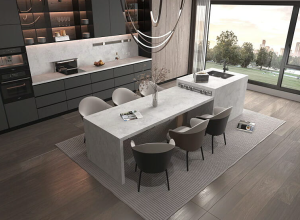A partial backsplash is a combination of function and aesthetics in kitchen and bathroom design, and it is a covering on a short segment of vertical wall located behind the countertops. Partial Backsplashes Unlike a standard full backsplash, which would continue from the countertop to the upper cabinets or the ceiling, a partial backsplash simply covers a portion of that area. A great compromise between protection and style catering to many different tastes as well as budgets.
Design and Height
A parital backsplash usually extends 4 to 6 inches above the countertop. This height will keep splashes and spills off your wall, particularly in wet and food preparation areas. The overall height is adaptable to individual requirements and design ambitions, but the standard height is very functional and desirable for a simple finish.
Material Choices
There are many materials that you can use for partial backsplashes. Common options include:
The Great Debate: MaterialsCeramic, porcelain, and glass tiles are always going to be the most popular due to their cost, durability, and ease of keeping clean. PS They also are available in numerous colors and fortunately any room color scheme.
Stone: Granite, marble, and quartz are top rating and provide a sleek and unifying appearance when paired with the counter top material.
Metal: Stainless steel and copper give off a clean, modern vibe and are ideal for contemporary or industrial-style kitchens.

Cost Considerations
A partial backsplash will cost less compared to a full backsplash This is primarily a result of the lower material and labor that goes into installation. Material choice also dramatically changes the price:
Tile: $5 to $20 per square foot (depending on type and quality).
Stone: $20 to $100 per square foot, particularly cleaner surfaces like those of natural granite and marble.
Metal: $15 to $50 per square foot, — depending on metal type and finish
Installation and Maintenance
Adding just one row of backsplash as a accent wall can be a pretty painless job. This process consists of determining the height you need, then cutting the materials to fit and of course, using the right adhesives to attach them to the wall. When it comes to tiles, the space between the tiles is sealed using grout, but it special sealants must be used for stone or metal backsplashes that will prevent getting stained or damaged.
Taking care of a partial backsplash is by no means a difficult task. Typical maintenance includes wiping the vinyl with mild soap and water. Materials like natural stone may require a reseal a few times a year in order to uphold their protective barrier against water and liquid stains.
Aesthetic Impact
A specific kitchen or restroom space will improve. This allows some color, texture and pattern to come into the space without overpowering it. A design like this can create a point of focus in the kitchen which is behind sinks and stoves and can give even more interest and personality to the space.
Versatility and Customization
However, you can customize a partial backsplash to an astonishing degree. Homeowners can combine materials, colors, and patterns to create the perfect look for their home. This might mean a partial kitchen ceramic tile backsplash punctuated with ornamental mosaic tile and a separate quartz partial backsplash with more of the same countertop in another area of the room (etch-introduced, not laminated).
Learning about the materials and designs can help you choose the right backsplash for your wants and needs, and here are some ideas reminiscent of partial backsplashes to help you design the perfect look It is this mix of functionality and form that keeps partial backsplash in the limelight for designers in homes being built today.